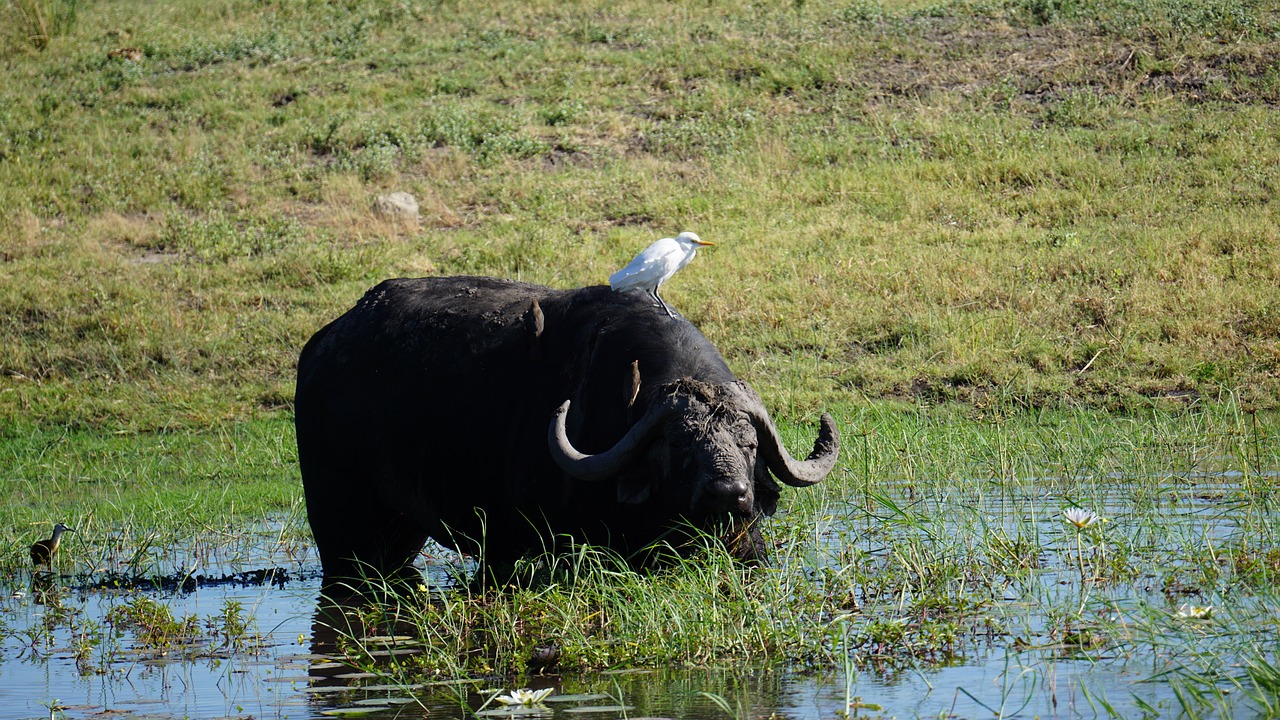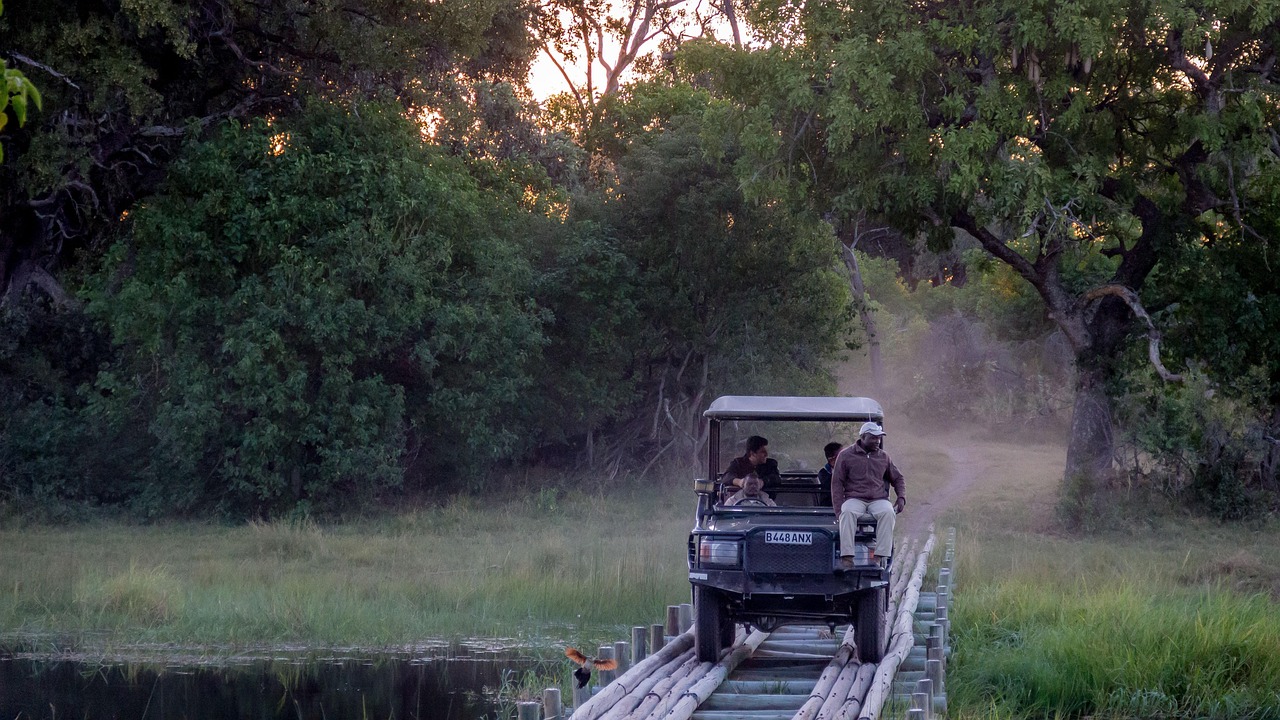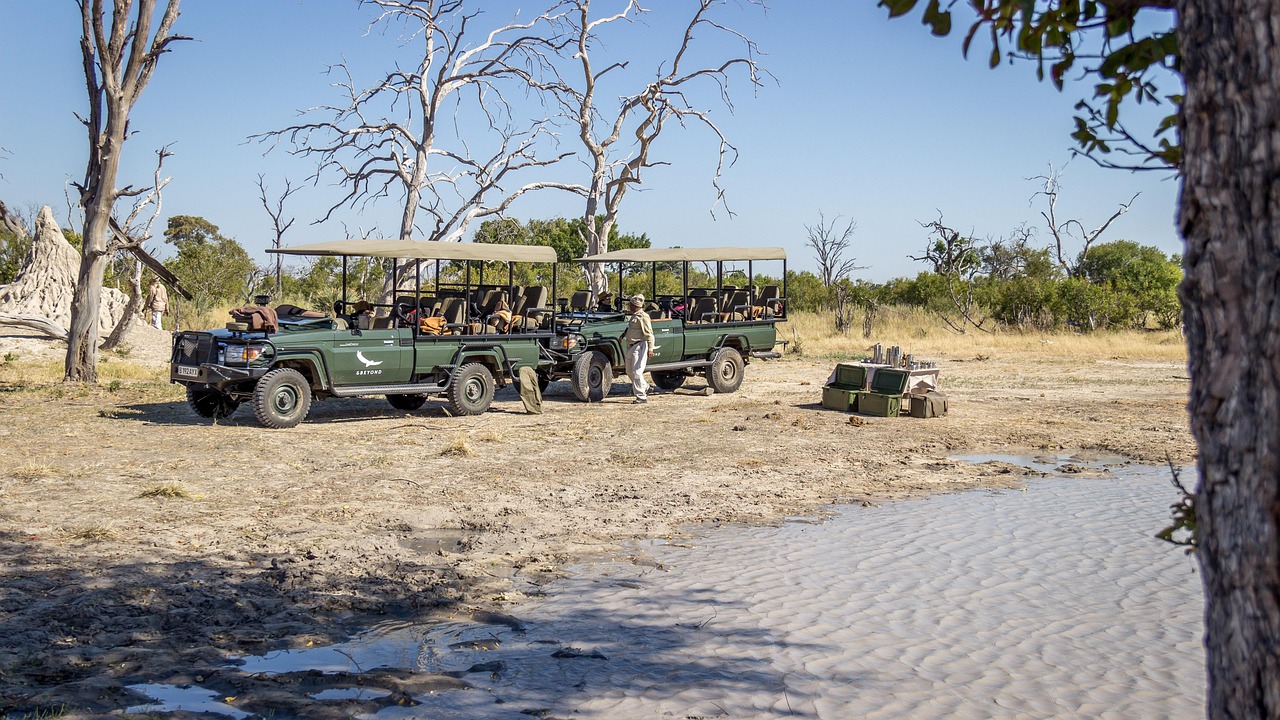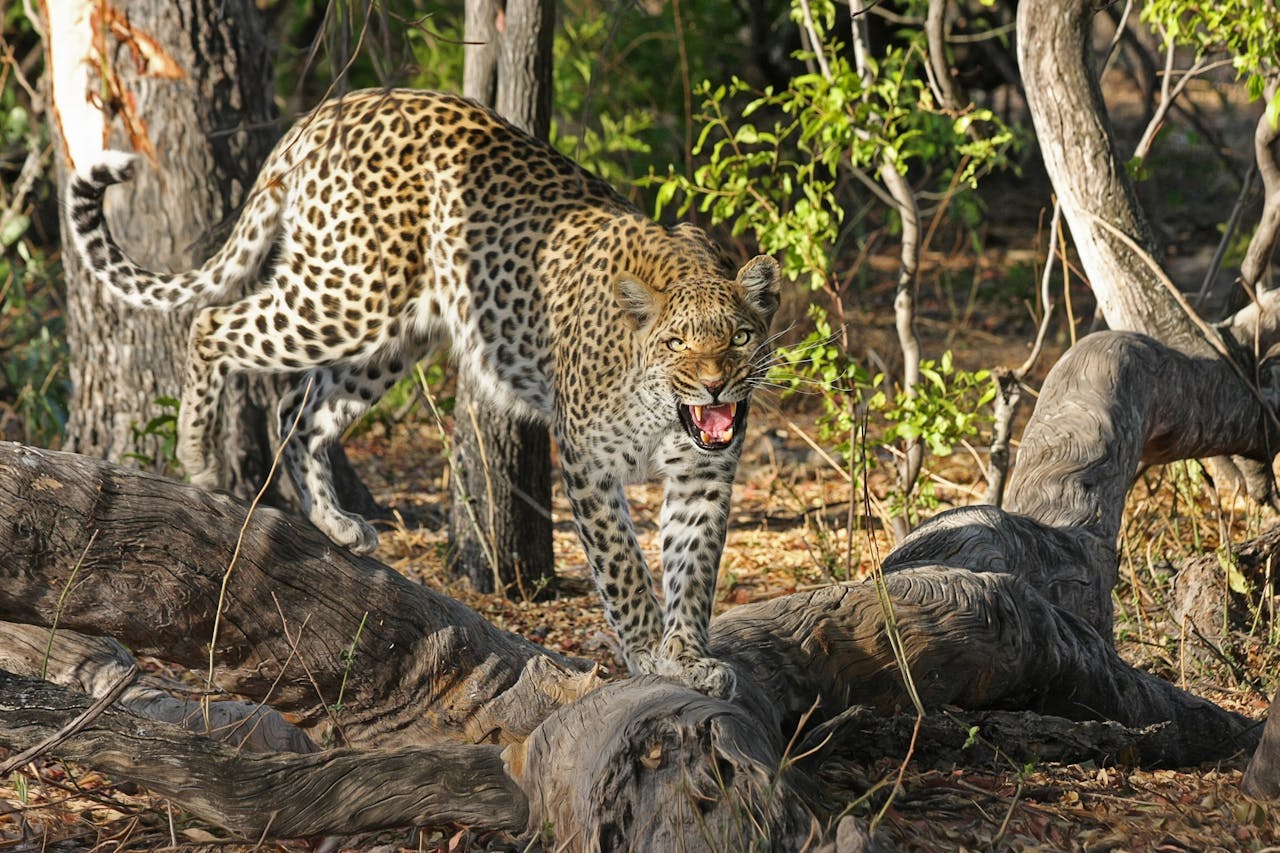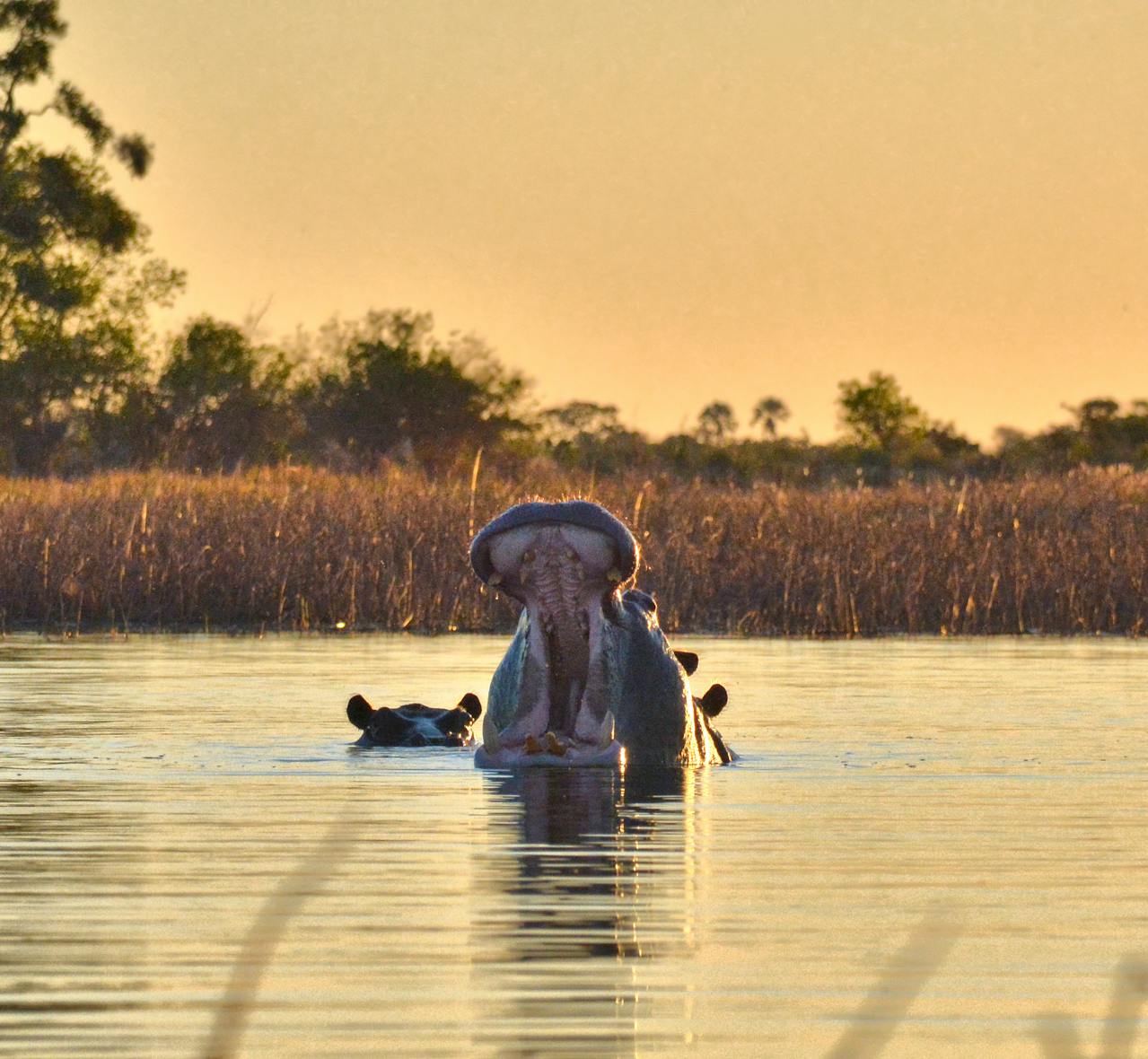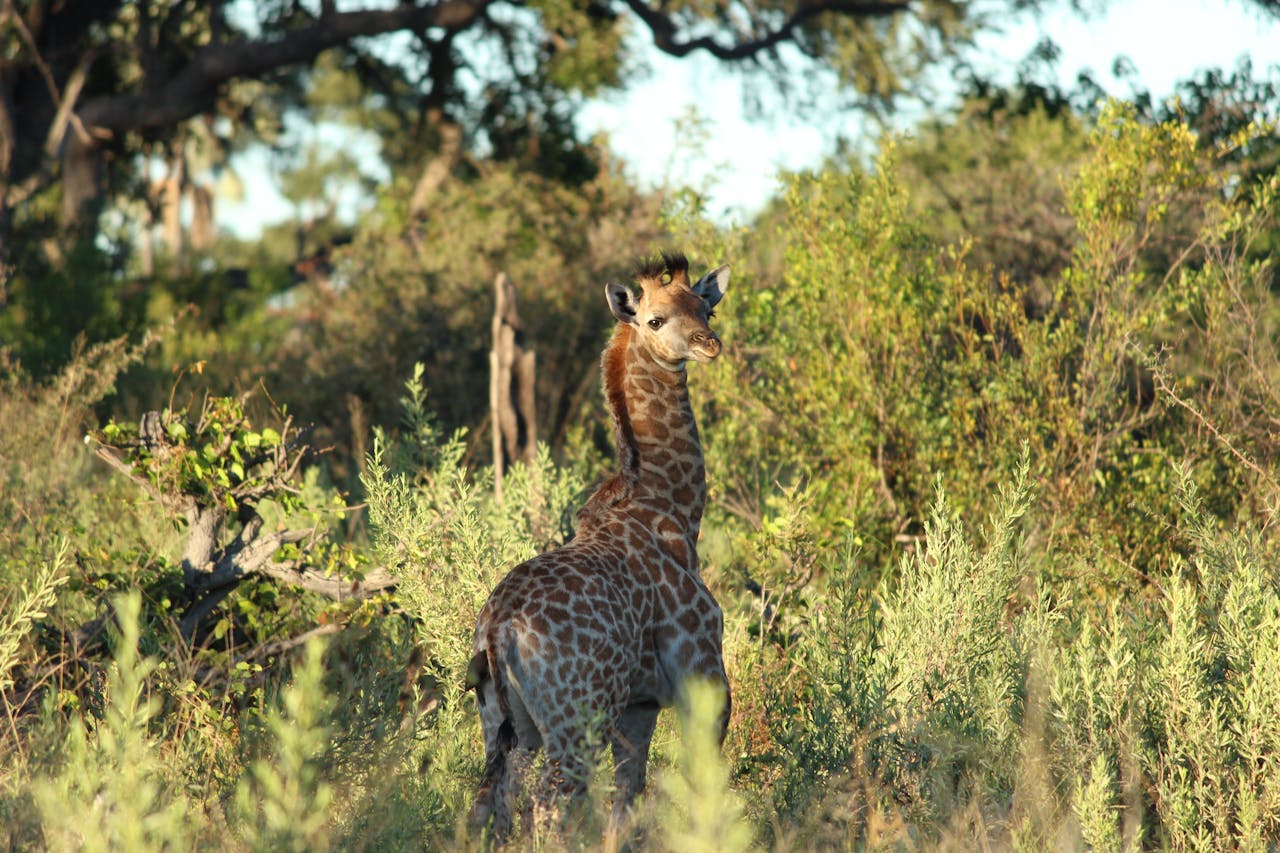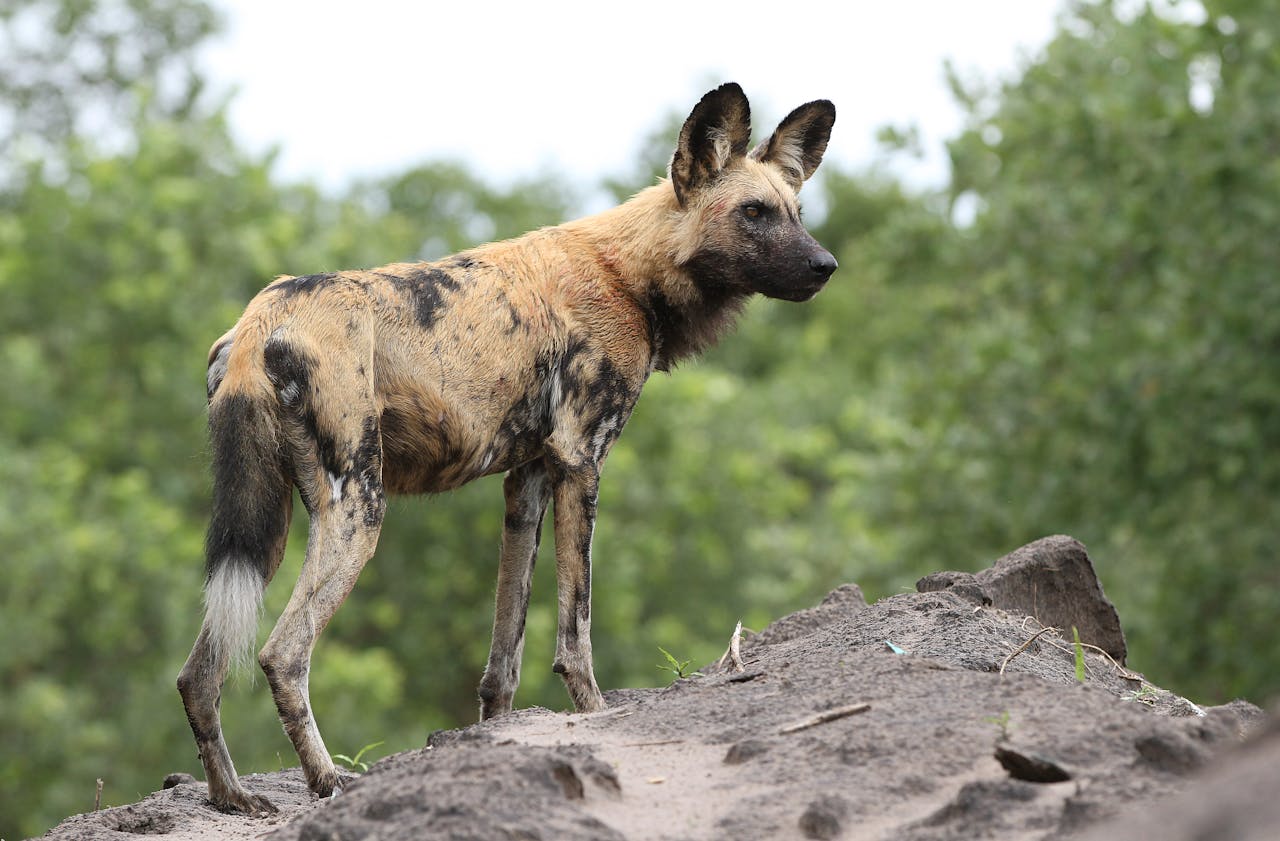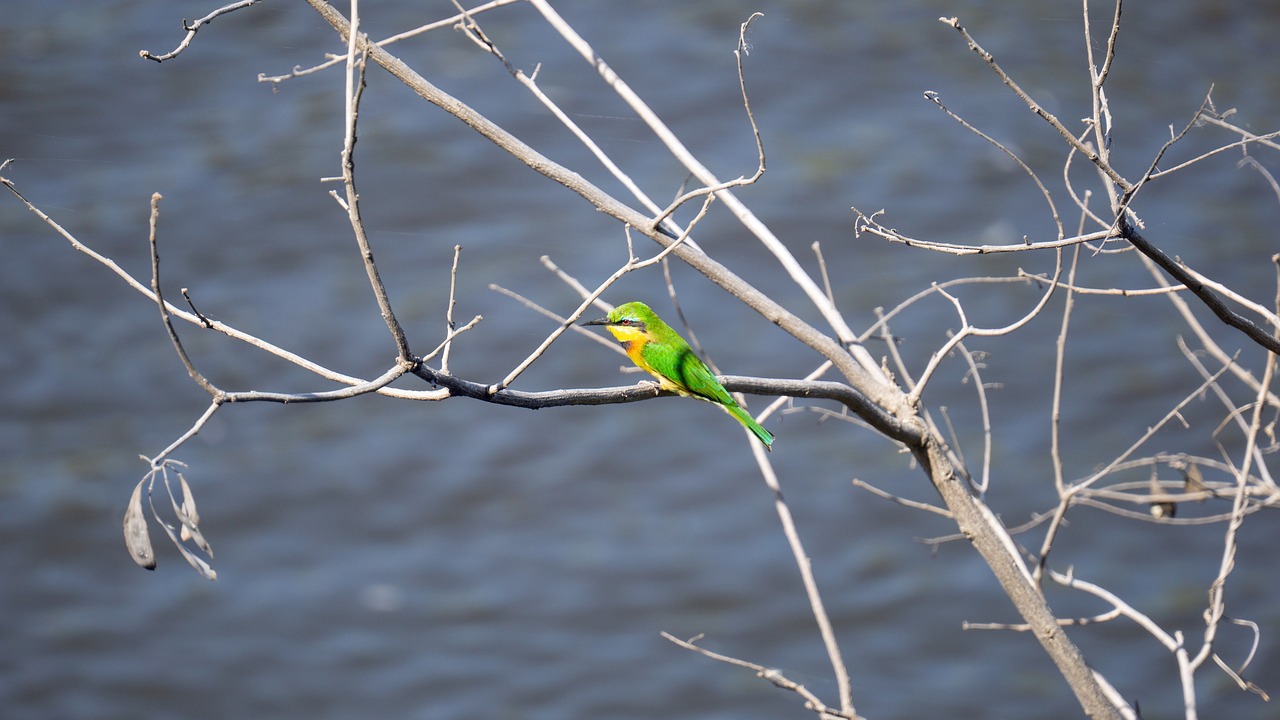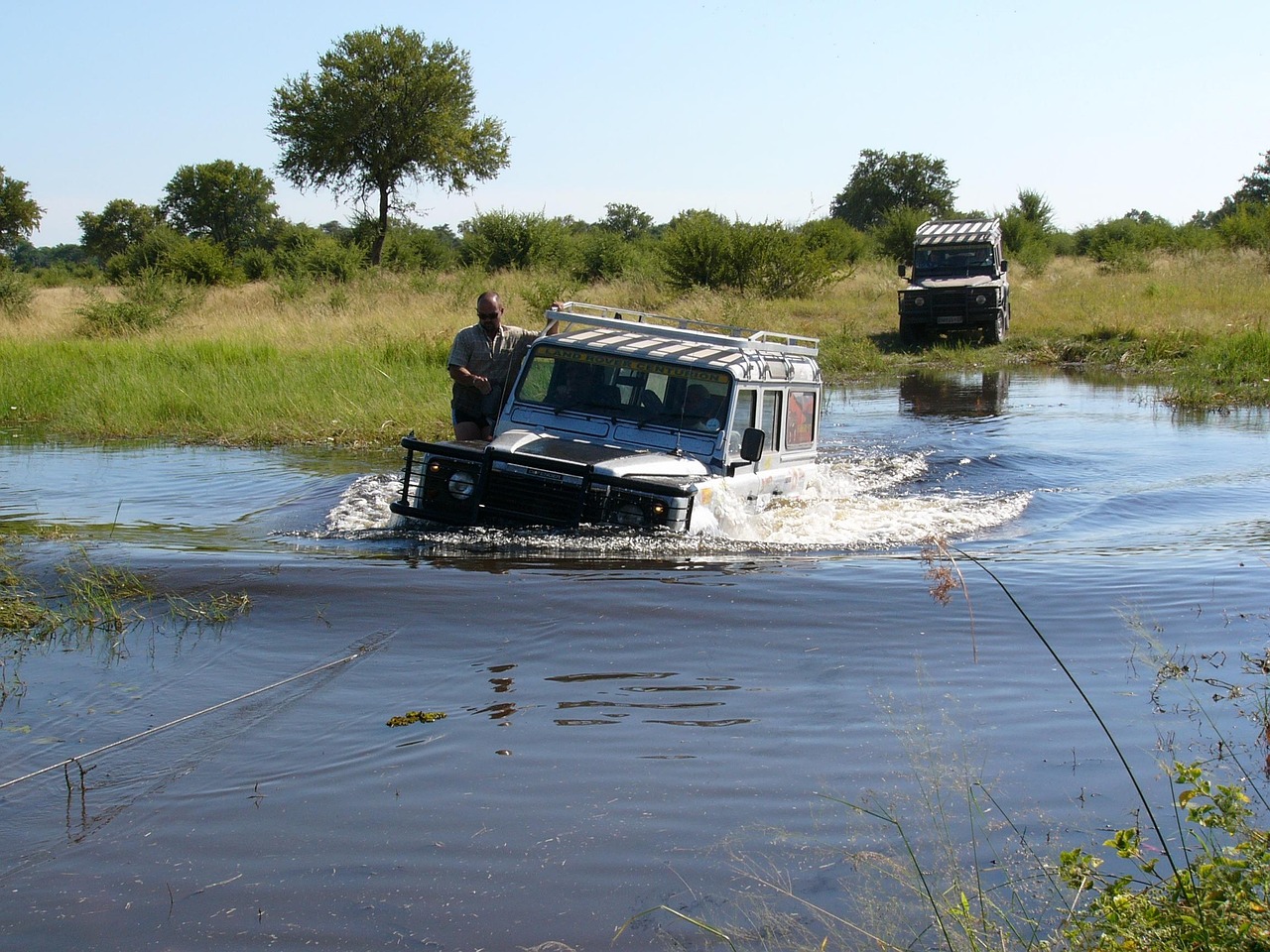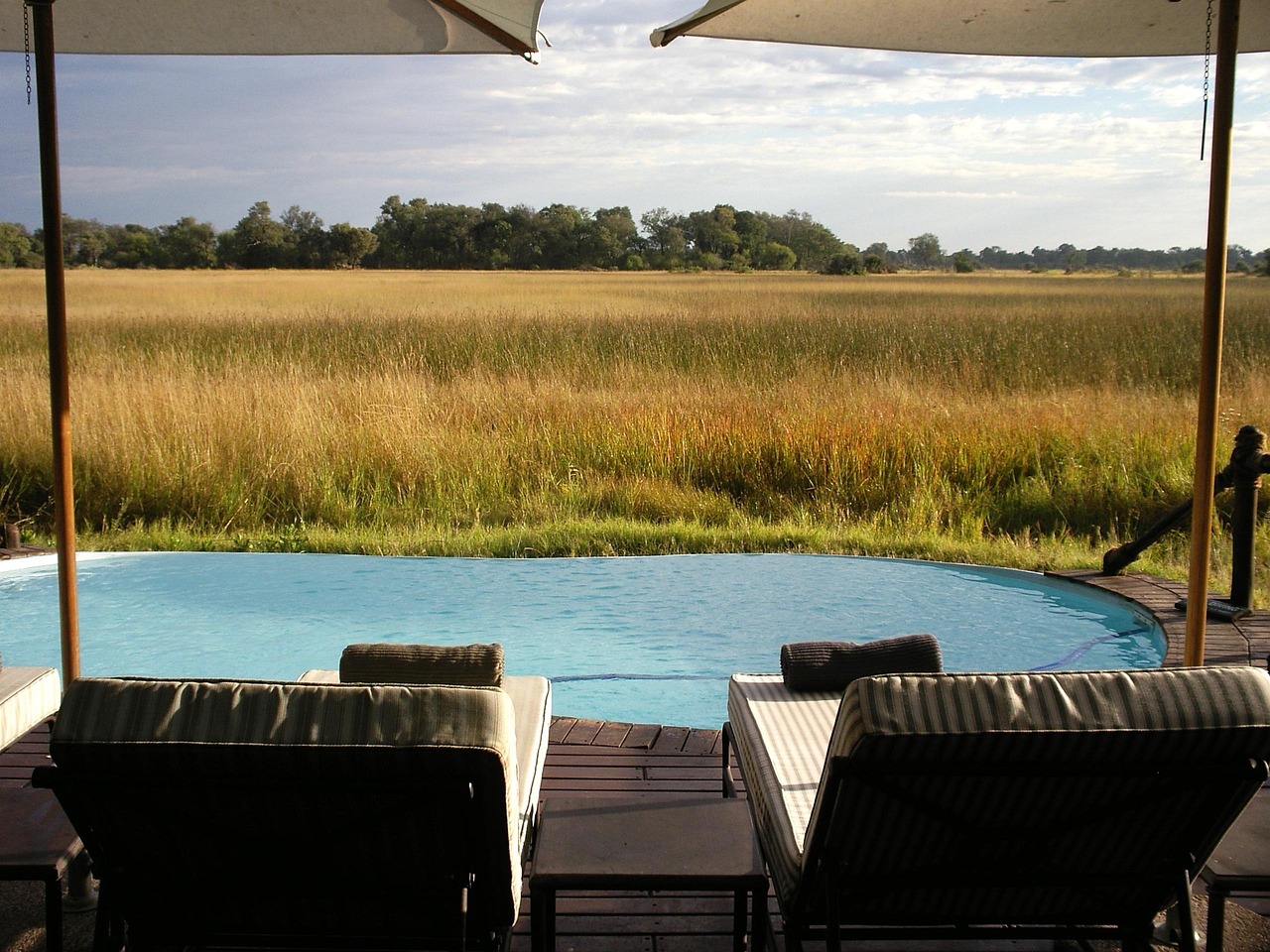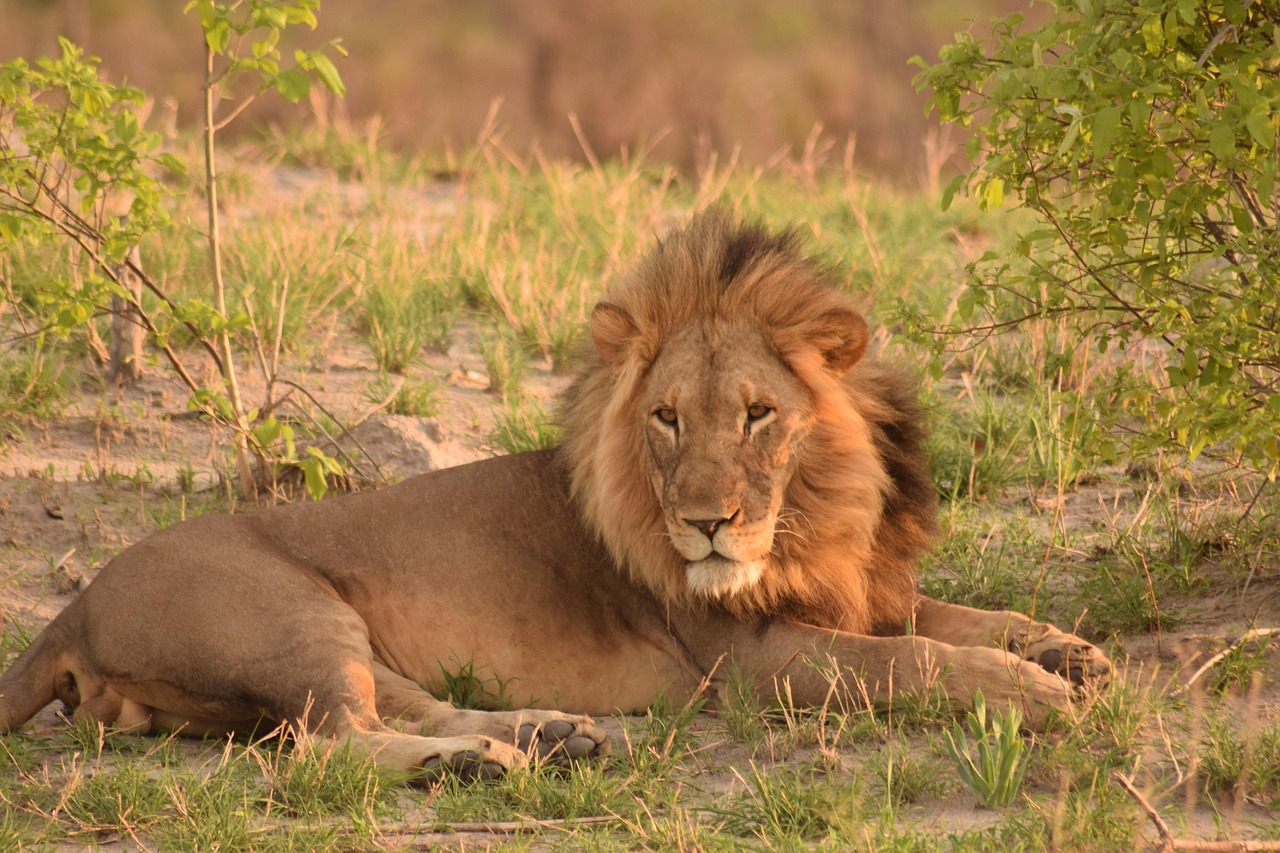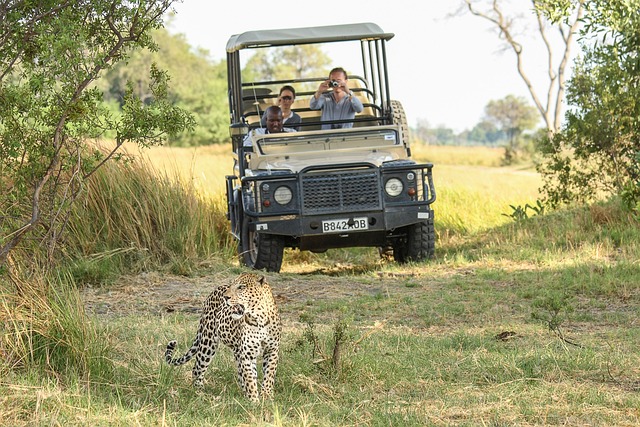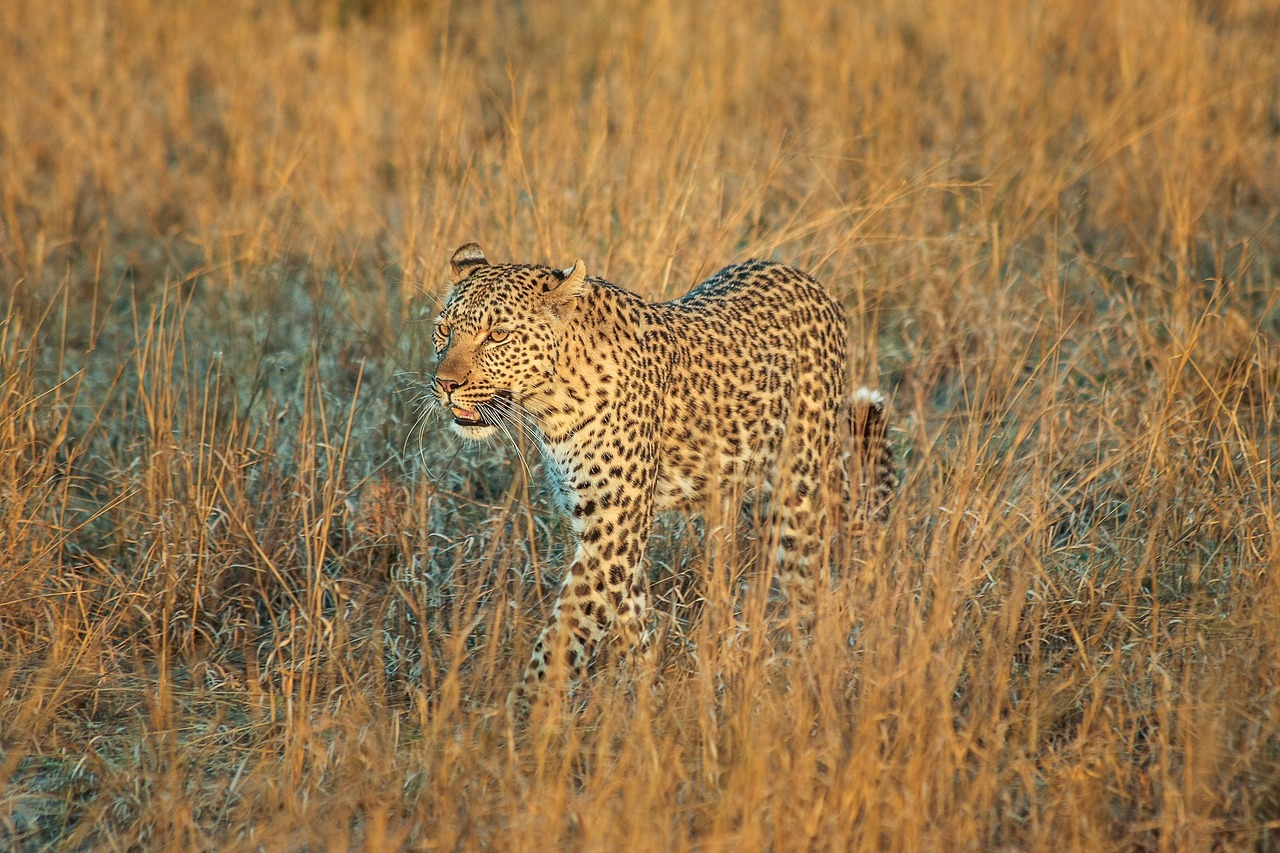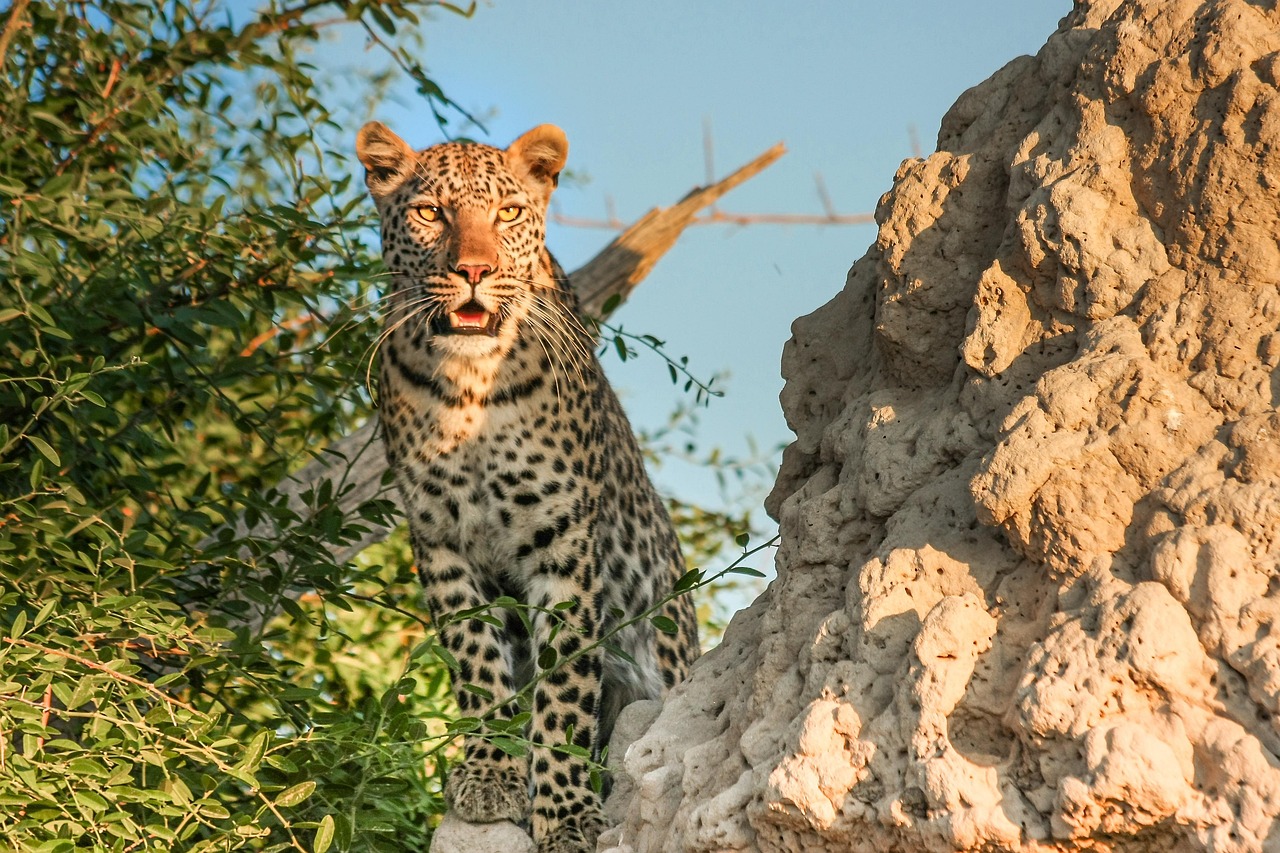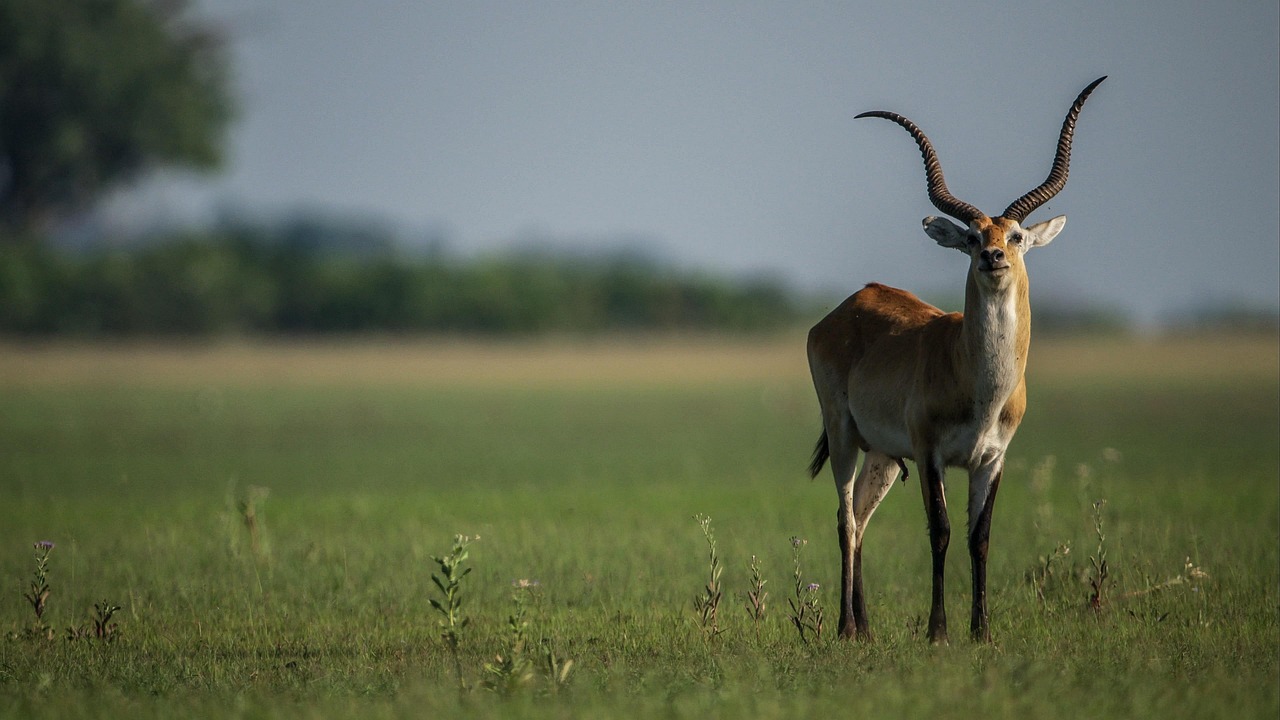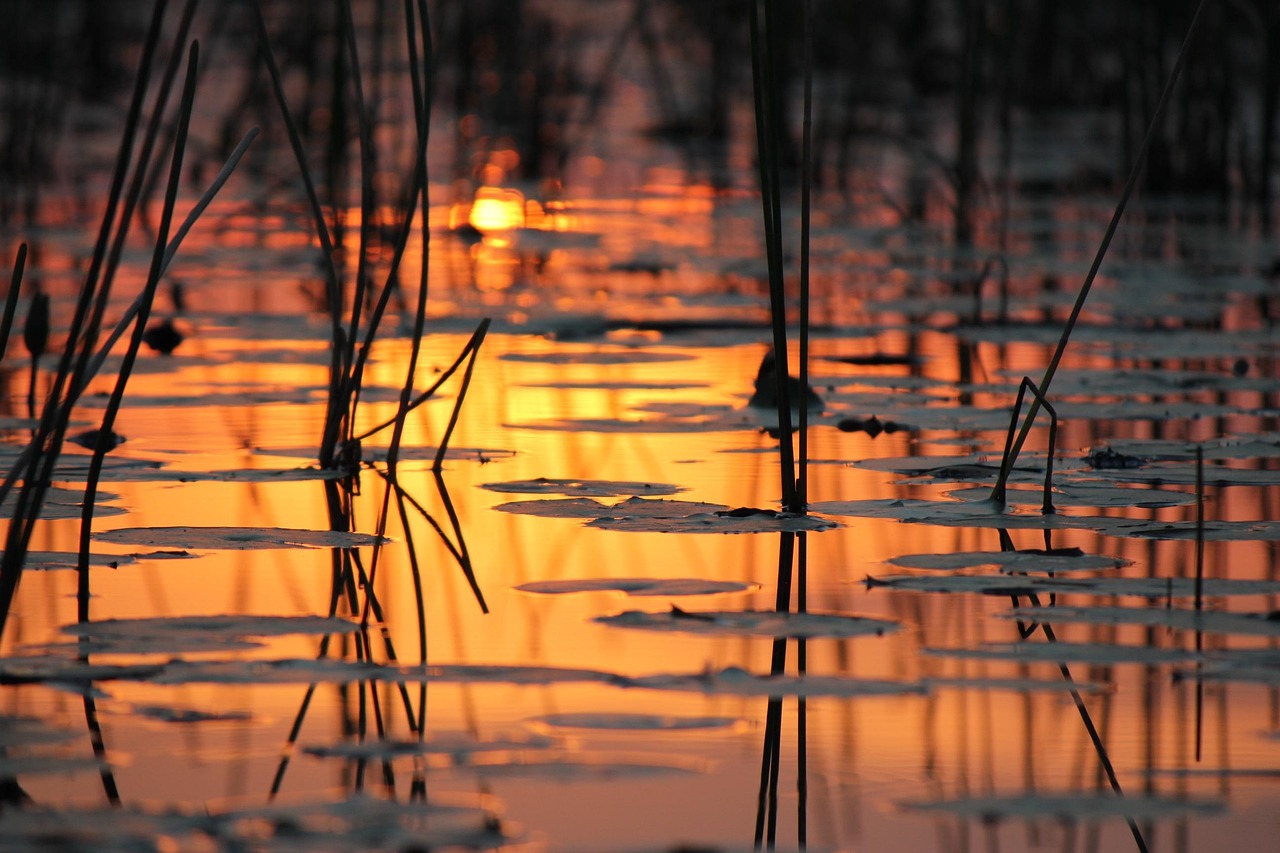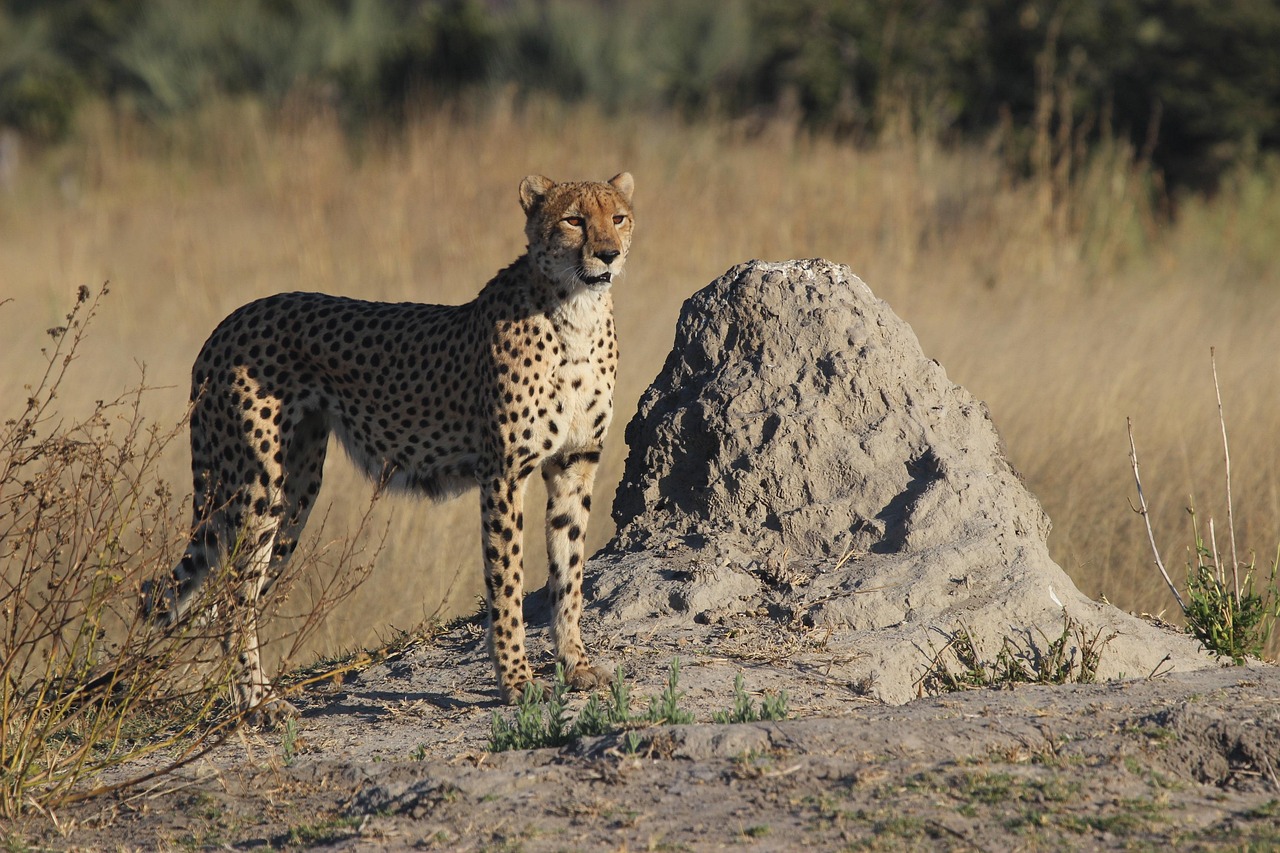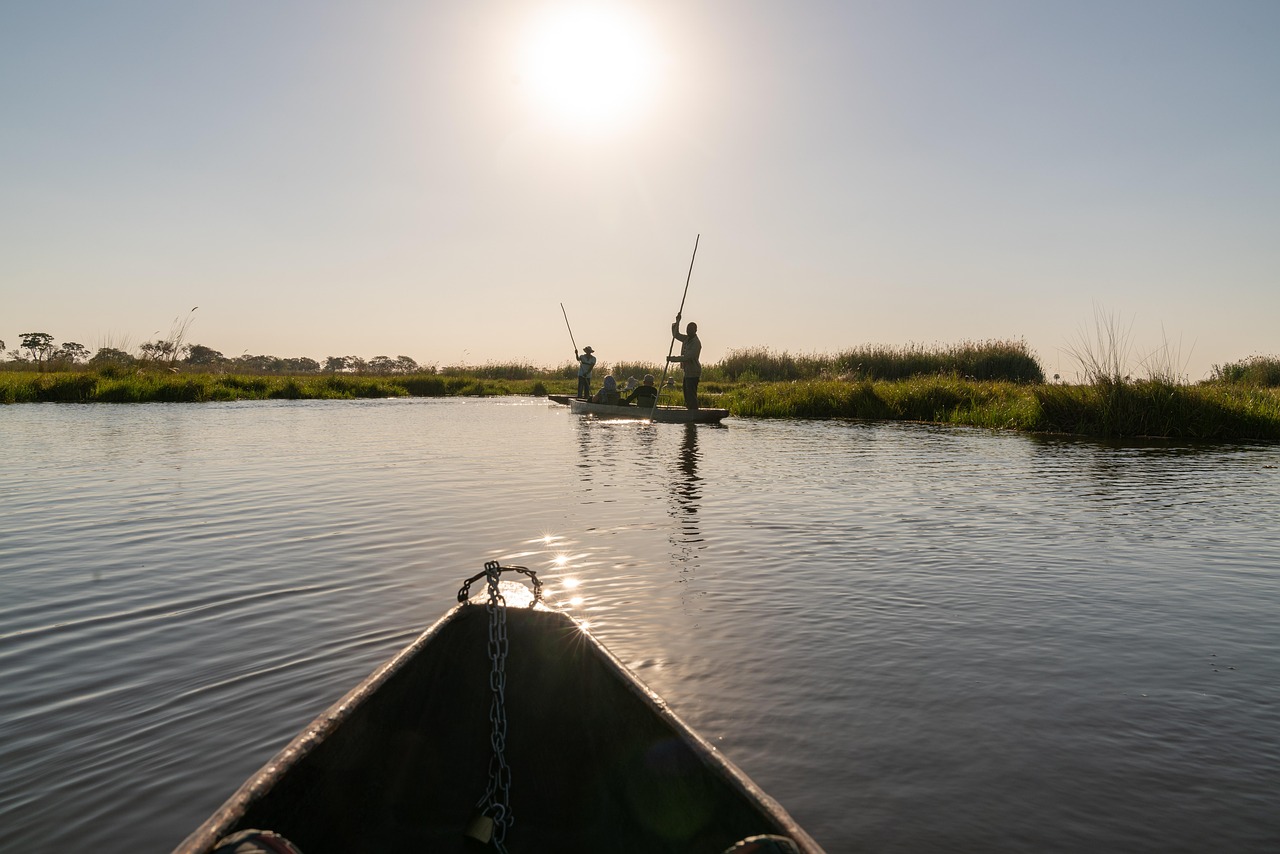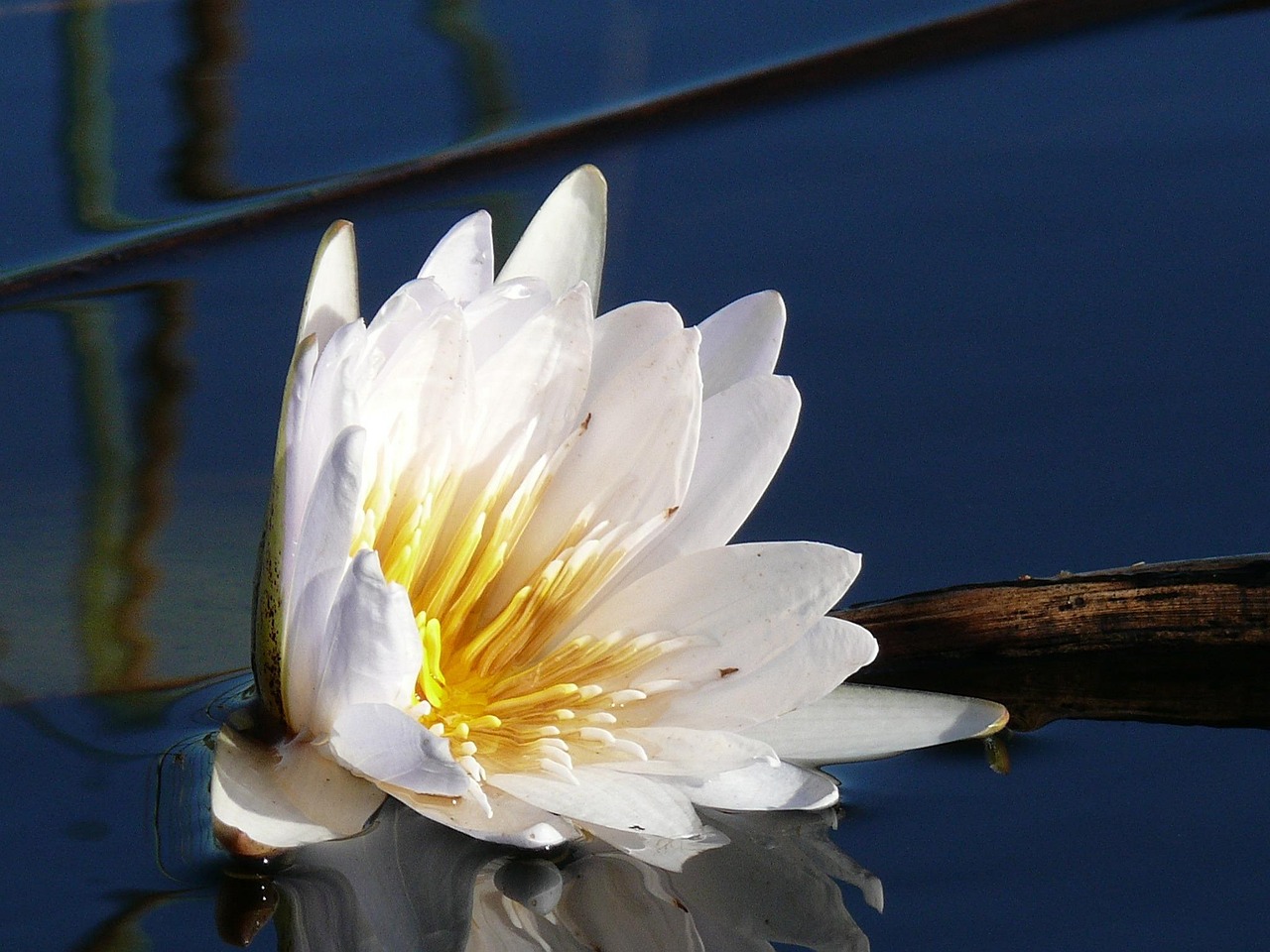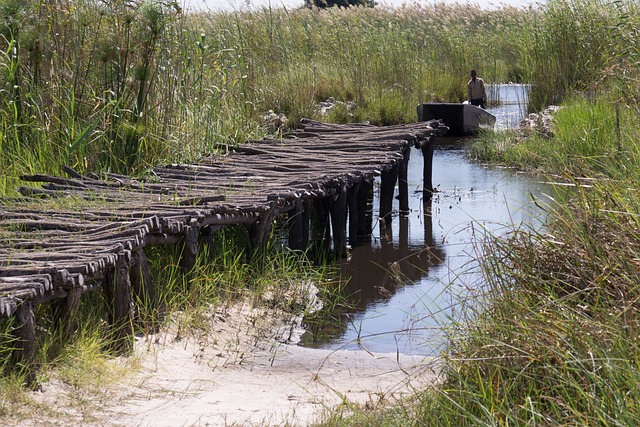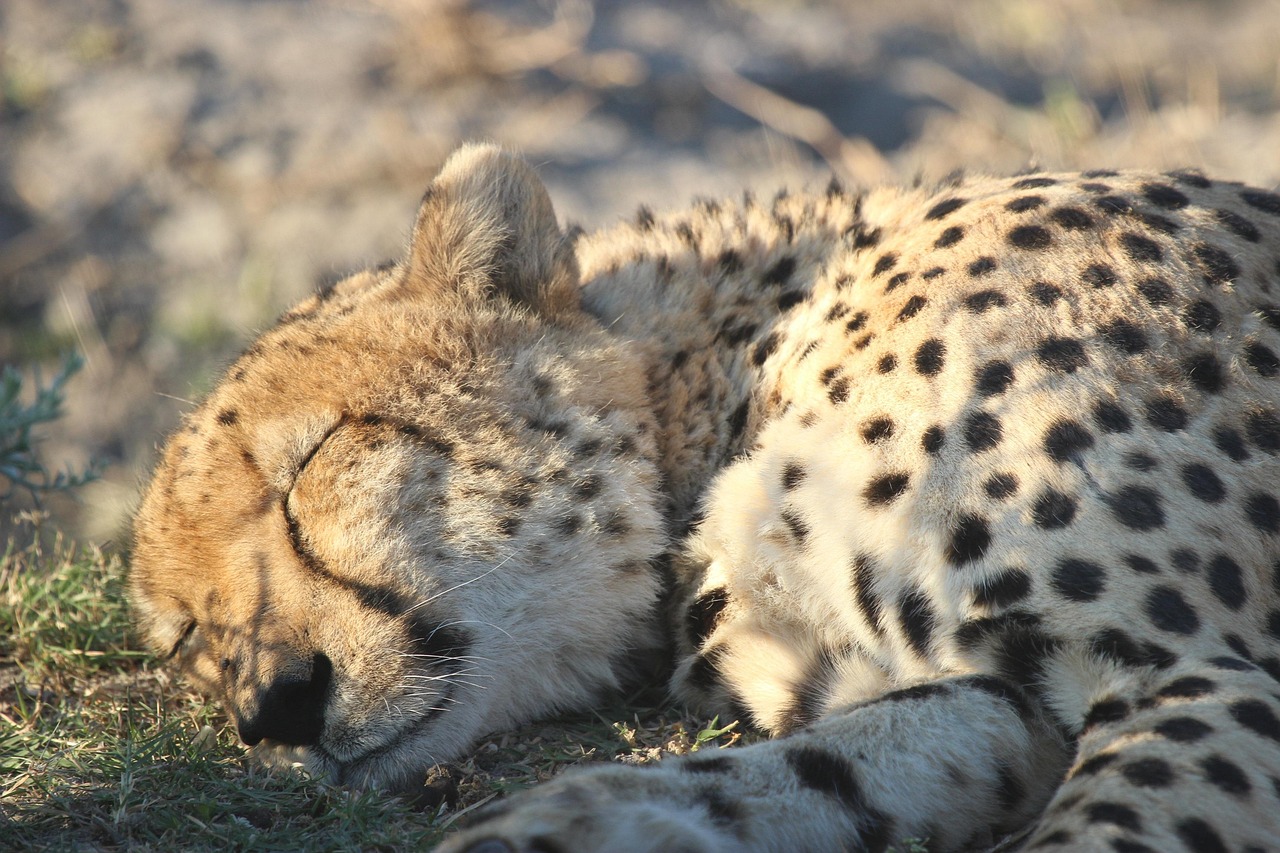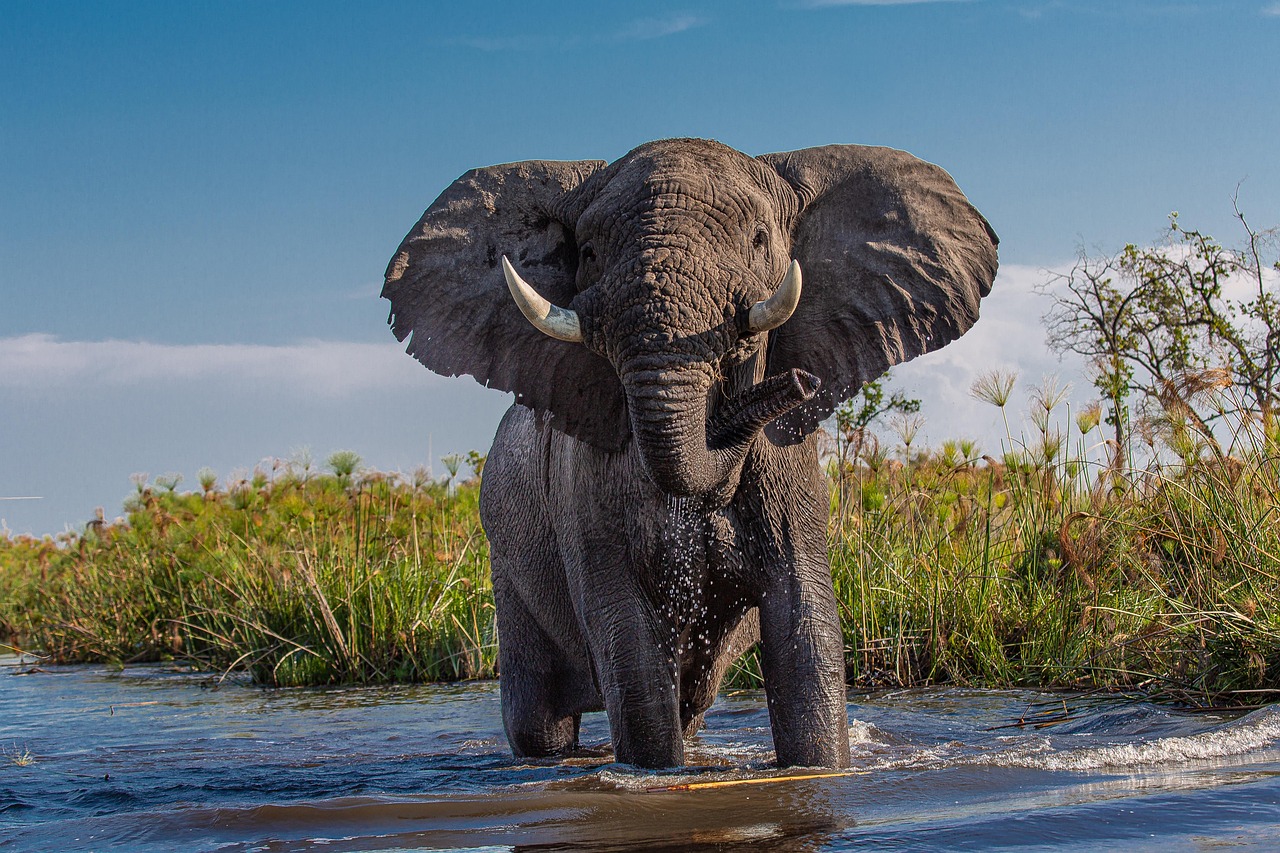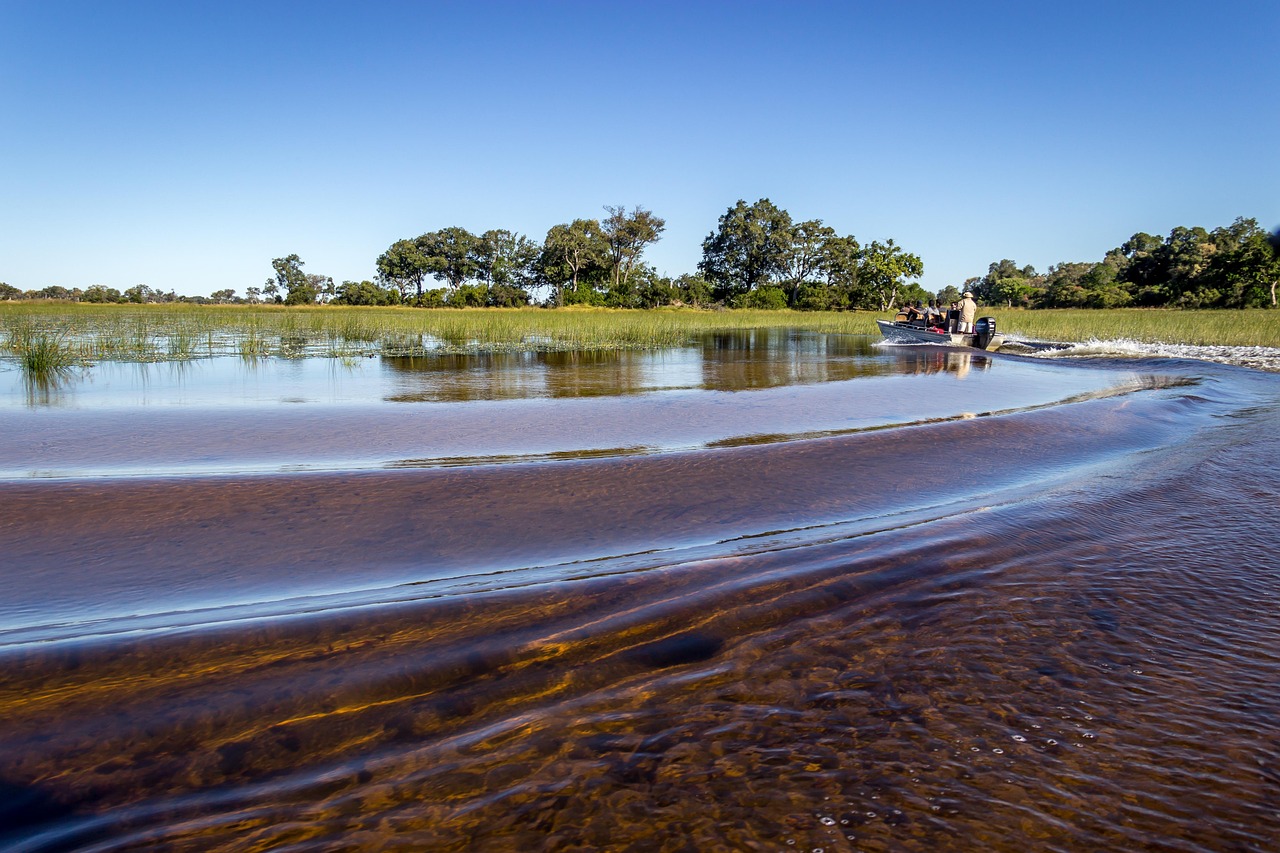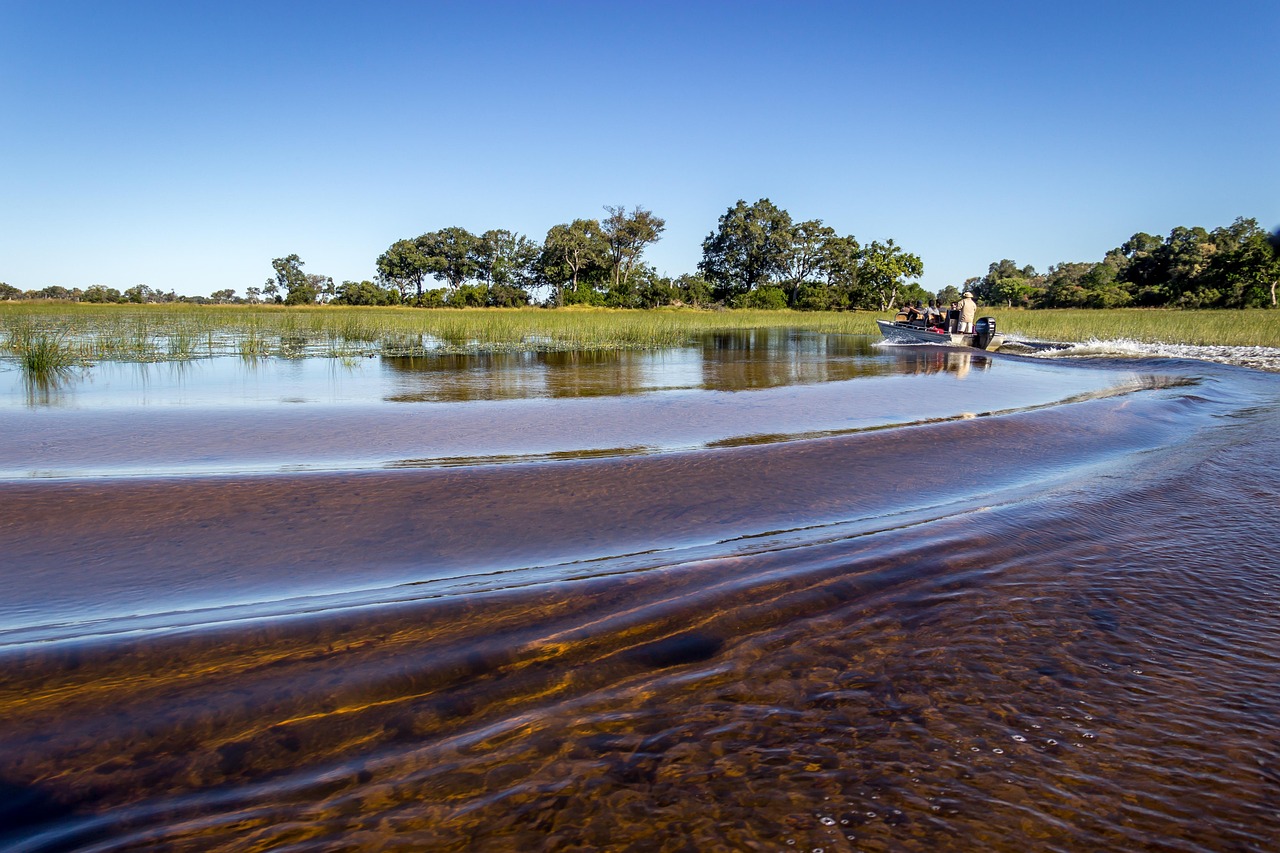
Okavango Delta Safari Region
Everything you need to know about the Okavango Delta. A complete travel guide.Okavango Delta (Botswana)
Overview
A Complete Travel Guide To The Okavango Delta.
Everything you need to know about the Okavango Delta Region before visiting for a safari.
The Okavango Delta Region in northern Botswana spans over two million hectares of inland floodplains, seasonal wetlands, islands and woodland — one of Africa’s few remaining wilderness areas and a UNESCO site. Fed by rainfall high in Angola, the Okavango River fans into an inland delta that never reaches the sea, drawing wildlife from far and wide into its lush channels and lagoons. Here, safarigoers glide through papyrus‑lined waterways by mokoro, combine bush walks with game drives and enjoy private lodges set in exclusive concessions. The region is home to dense concentrations of elephants, hippos, buffalo, lechwe, wild dogs and all of Africa’s Big Five, supported by diverse habitats and strong conservation policies.
Explore the Okavango Delta Region Below:
Explore Other Regions
Continue your safari planning journey across Africa’s top safari regions
Not sure if the Okavango Delta Region is your perfect fit? Click below to explore and compare other safari regions.
Safety
Everything you need to know about safety in the Okavango Delta Region
Botswana is widely regarded as one of Africa’s safest destinations, with low crime in rural areas and tourist areas such as Maun. Standard precautions—locking vehicles, securing valuables, avoiding isolated places at night—will keep most risks very low.
Expert tip: Book guides and transfers through reputable lodges or tour operators, especially when travelling at night or between towns in the Okavango Delta region.
A Deeper Understanding Of Safety In the Okavango Delta Region
The Okavango Delta Region and nearby towns like Maun offer a generally safe environment for travellers. Violent crime against tourists is rare, particularly within wildlife areas and private concessions where trained guides oversee game drives and bush walks. Petty theft—such as pickpocketing or vehicle break-ins—is more likely in urban centres such as Gaborone, Francistown or Maun, especially near markets, airports or at traffic lights. It’s wise to keep valuables out of sight, lock vehicles, and avoid walking alone after dark.
Driving risks include smash‑and‑grab thefts at intersections and hazardous road conditions in remote areas. Avoid driving after dark and park in well-lit, attended areas.
Within wildlife areas—including national parks and private reserves—wildlife encounters are managed by professional guides. Never exit vehicles except under direct supervision. Follow lodge rules strictly.
Health-wise, malaria is present in the Delta from approximately November to June. Use insect repellent, sleep under nets, and consult a doctor about prophylaxis. Limited medical facilities exist in rural zones—comprehensive travel insurance with evacuation coverage is strongly recommended.
Malaria
Everything you need to know about malaria in the Okavango Delta Region
Malaria risk exists in the Okavango Delta Region from September through May, with high seasonal risk during the rainy months and moderate risk in the drier winter (June–August). Preparations are recommended year-round.
- Malaria Area: Yes
- Malaria Risk Level in Okavango Delta Region: 🔴 High (September–May) / 🟠 Medium (June–August)
- Use the following link to find malaria and vaccination information for the Okavango Delta Region: https://skyteam.traveldoc.aero/
Expert tip: Book a travel health consultation before your trip and pack both mosquito repellent and antimalarial medication if visiting during or near the rainy season.
A Deeper Understanding Of Malaria In the Okavango Delta Region
The Okavango Delta Region, including Maun, lies within Botswana’s northern malaria belt. The highest transmission occurs during the rainy season (November to April), with peak risk from September through May, while June–August sees moderate risk when drier conditions suppress mosquito breeding.
All travellers to this region should consider chemoprophylaxis, especially children, pregnant women or long‑stay visitors. Standard advice includes using insect repellent, wearing long, light-coloured clothing, sleeping under insecticide-treated nets, and staying in insect-screened or air‑conditioned lodges.
If fever or flu‑like symptoms occur during or up to a month after travel, get tested promptly. Though safari visitors rarely fall ill, early diagnosis and treatment are essential.
Malaria Risk by Month in Okavango Delta Region
🟢 Malaria Free, 🟡 Low Risk Of Malaria, 🟠 Medium Risk Of Malaria, 🔴 High Risk Of Malaria
| Month | Risk |
|---|---|
| January | 🔴 High Risk Of Malaria |
| February | 🔴 High Risk Of Malaria |
| March | 🔴 High Risk Of Malaria |
| April | 🔴 High Risk Of Malaria |
| May | 🔴 High Risk Of Malaria |
| June | 🟠 Medium Risk Of Malaria |
| July | 🟠 Medium Risk Of Malaria |
| August | 🟠 Medium Risk Of Malaria |
| September | 🔴 High Risk Of Malaria |
| October | 🔴 High Risk Of Malaria |
| November | 🔴 High Risk Of Malaria |
| December | 🔴 High Risk Of Malaria |
Weather and climate
Everything you need to know about weather and climate in the Okavango Delta Region
The Okavango Delta Region has a hot, wet summer (November–March) with afternoon storms and high humidity, followed by a dry, cooler winter season (June–August) with crisp mornings and sunny days. Rainfall and moisture drop sharply during winter.
Seasonal Breakdown:
- Summer: From November to March, average highs reach 31–33 °C (88–91 °F) with humid afternoons and heavy rainfall around 100–110 mm (4–4 in) per month. Nights remain warm.
- Winter: From June to August, mornings can dip to 6–7 °C (43–45 °F), with comfortable daytime highs near 25–26 °C (77–79 °F). Rain is rare, typically under 5 mm (0.2 in).
Expert tip: Pack layers for early-morning safaris during winter and sun protection and light rain gear for summer visits.
A Deeper Understanding Of Weather And Climate In the Okavango Delta Region
The summer (wet season from November to March) coincides with summer rainfall in Angola that feeds the Okavango River. Expect daily heavy afternoon thunderstorms, high humidity (up to 80 %), and swollen wetlands supporting lush vegetation and wildlife. Temperatures are hot and humid, especially in December and February.
The dry winter season (April to August) brings clear skies, crisp early mornings, and cool evenings. The delta floods during this period, offering prime wildlife visibility as animals gather around permanent water. Daytime temperatures remain pleasant around mid-20s °C.
Shoulder seasons (March–May, September–October) offer transitional weather — the bush turns green in April/May after rains, and September/October brings rising temperatures before the next rains. These months suit travellers seeking fewer crowds, moderate heat, and excellent game viewing.
Table representing weather and climate in the Okavango Delta Region by month
🟢 Excellent weather | 🟡 Fair weather | 🟠 Hot or rainy conditions | 🔴 Unfavourable travel period
| Month | Avg Low (°C/°F) | Average High (°C/°F) | Precipitation (%) | Rainfall (mm/in) | Rainy Days | Humidity (%) | UV Index |
|---|---|---|---|---|---|---|---|
| January | 20 / 68 °F | 32 / 90 °F | High | 107 / 4.2 in | ~12 | 80 % | High |
| February | 19 / 66 °F | 32 / 90 °F | High | 71 / 2.8 in | ~10 | ~75 % | High |
| March | 17 / 63 °F | 31 / 88 °F | Medium | 71 / 2.8 in | ~10 | ~70 % | High |
| April | 15 / 59 °F | 31 / 88 °F | Medium | 18 / 0.7 in | ~5 | ~60 % | High |
| May | 11 / 52 °F | 28 / 82 °F | Low | 5 / 0.2 in | ~2 | ~50 % | High |
| June | 6 / 43 °F | 25 / 77 °F | Low | 3 / 0.1 in | <1 | ~45 % | High |
| July | 6 / 43 °F | 26 / 79 °F | Low | 4 / 0.16 in | <1 | ~45 % | High |
| August | 10 / 50 °F | 28 / 82 °F | Low | 5 / 0.2 in | <1 | ~50 % | High |
| September | 14 / 57 °F | 34 / 93 °F | Medium | 7 / 0.3 in | ~2 | ~55 % | High |
| October | 18 / 64 °F | 36 / 97 °F | Medium–High | 16 / 0.6 in | ~4 | ~60 % | High |
| November | 19 / 66 °F | 33 / 91 °F | Medium–High | 56 / 2.2 in | ~8 | ~65 % | High |
| December | 20 / 68 °F | 33 / 91 °F | High | 86 / 3.4 in | ~10 | ~75 % | High |
When To Go
Everything you need to know about the best time to visit the Okavango Delta Region:
The best time to visit the Okavango Delta Region is during the dry season from June to October, when wildlife viewing is at its peak and game concentrates around permanent water channels. For birdwatchers and green landscapes, visit during the wet season.
When To Go | Jan | Feb | March | Apr | May | Jun | Jul | Aug | Sep | Oct | Nov | Dec |
= Excellent = Good = Fair = Poor
- High season: June–October
- Low season: November–March
Expert tip: For fewer crowds and lush scenery at better rates, opt for April–May or September, which offer good wildlife activity and transitional weather.
A Deeper Understanding Of The Best Time To Visit the Okavango Delta Region
Visiting between June and October offers excellent game viewing, as animals cluster around the flooded channels arriving from Angola while vegetation thins and visibility improves. Flood levels typically peak between July and August. This is the high season, with premium lodge rates but unmatched wildlife density.
The wet or "green" season (November–March) brings heavy rains, lush vegetation and spectacular bird migration, making it ideal for birders and nature photographers — though wildlife can be more dispersed and some lodges may close during the wettest months.
Shoulder months (April–May, September–October) combine moderate temperatures, fewer crowds, rising floodwaters, and improving game viewing — and often better value.
| Month | Weather | Wildlife Viewing | Birdwatching | Temperature |
|---|---|---|---|---|
| January | 🌧️ Wet | ✅ | 🐦🐦🐦 | 🔥 Hot |
| February | 🌧️ Wet | ✅ | 🐦🐦🐦 | 🔥 Hot |
| March | 🌧️ Wet | ✅ | 🐦🐦🐦 | 🔥 Hot |
| April | 🌤️ Partly Cloudy | ✅ | 🐦🐦 | ☀️ Warm |
| May | 🌤️ Partly Cloudy | ✅✅ | 🐦🐦 | ☀️ Warm |
| June | ☀️ Dry | ✅✅✅ | 🐦🐦 | ☀️ Warm |
| July | ☀️ Dry | ✅✅✅ | 🐦🐦 | ☀️ Warm |
| August | ☀️ Dry | ✅✅✅ | 🐦🐦 | ☀️ Warm |
| September | 🌤️ Partly Cloudy | ✅✅✅ | 🐦🐦 | 🔥 Hot |
| October | 🌤️ Partly Cloudy | ✅✅✅ | 🐦🐦 | 🔥 Hot |
| November | 🌧️ Rain | ✅ | 🐦🐦🐦 | 🔥 Hot |
| December | 🌧️ Rain | ✅ | 🐦🐦🐦 | 🔥 Hot |
Table Legend:
Weather: ⛈️ Thunderstorms, 🌧️ Rain, 🌤️ Partly Cloudy, ☀️ Dry
Wildlife Viewing: ✅ Average, ✅✅ Good, ✅✅✅ Great
Birdwatching: 🐦 Average, 🐦🐦 Good, 🐦🐦🐦 Great
Temperature: ❄️ Cold, ☀️ Warm, 🔥 Hot
Cities and Towns
Everything you need to know about Cities and Towns in the Okavango Delta Region:
Maun is the primary town in the Okavango Delta Region and serves as the gateway for almost all safari departures. It offers lodges, shops, restaurants, local crafts and charter flights into Moremi Game Reserve and private concessions.
Most Popular Cities and Towns in the Okavango Delta Region:
- 🥇 Maun: As the region’s tourism capital, Maun acts as a launch point to the Okavango Delta. It features Maun International Airport, numerous safari operators, and a range of accommodations, from guesthouses to riverfront hotels.
Expert tip: Arrange your safari transfers and charter flights via reputable tour operators based in Maun, where most lodges coordinate reliable transport into the bush. Explore the Okavango Delta Region safari regions below:
Getting Here
Everything you need to know about getting to the Okavango Delta Region:
Travellers typically fly into Maun International Airport, then transfer by shared charter flight or a short road or boat journey to lodge airstrips. Entry is relatively straightforward, though organising transfers in advance is key.
- Main point of entry to the Okavango Delta Region: Maun International Airport
- Effort to get to Okavango Delta Region: 🟡 Medium
- Effort getting around Okavango Delta Region: 🟡 Medium
- Best ways to get around Okavango Delta Region: ✈️ Air; 🚙 Transfers; 🚤 Boat
Expert tip: Book your internal charter flights and onward camp transfers at the time of lodge booking to guarantee smooth connections from arrival in Maun.
A Deeper Understanding Of Getting To the Okavango Delta Region
By Air
Most visitors arrive via Maun International Airport (MUB)—the gateway to the Delta—with daily scheduled flights from Johannesburg and Cape Town offered by Airlink and Air Botswana (about a 2-hour journey). From Maun, travellers depart on shared charter flights (e.g., via Mack Air or Wilderness Air), typically 15–45 minutes in small aircraft to lodge airstrips inside the Delta.
By Road
Driving into the Delta is rare and generally not recommended. Self-driving via 4×4 from Maun to some lodges or Moremi Game Reserve is possible, typically taking 30–90 km depending on gate location. However, most wildlife camps are unreachable by road due to seasonal flooding and remote terrain.
Transfers and Accessibility
After landing at Maun Airport, you’ll be met by lodge staff or guides who assist with charter flight boarding and baggage handling. In cases of flooding, transfers may combine boat or road segments. Charter flights are often shared and may stop at multiple airstrips en route (so-called “seat-in-plane” service). Transfers are usually included in safari itineraries and planned around flight schedules to minimise waiting times.
Why Visit
This is why you should visit the Okavango Delta Region:
The Okavango Delta Region offers a unique safari experience with diverse wildlife, water‑based safaris, and rich birdlife in a pristine inland delta. It suits travellers seeking tranquillity, varied habitats, and immersive nature time.
Expert tip: Travel during the dry winter months (June–October) for superb animal sightings at water channels; for lush scenery and bird activity, visit in the wet season (November–March).
A Deeper Understanding Of Why You Should Visit the Okavango Delta Region
The Okavango Delta is an inland floodplain fed by seasonal rains from Angola, creating a lush mosaic of channels, lagoons and islands in the Kalahari Desert, while the surrounding desert remains arid. This UNESCO World Heritage Site supports abundant wildlife, including Africa’s Big Five and large packs of wild dogs, drawn from surrounding reserves and concessions.
The region’s low‑impact tourism model, with private concessions and exclusive lodges, offers intimate and tranquil safari encounters often without crowds. Float silently in a traditional mokoro, track wildlife on guided walks, or admire birds and landscapes from the air by helicopter or light aircraft.
Highlight: ecological marvel.
The Okavango Delta is a rare inland delta oasis, flooding each year to sustain a rich ecosystem in the heart of the dry Kalahari Desert. That seasonal pulse creates concentrated wildlife gatherings unmatched elsewhere.
Highlight: diverse safari formats.
Enjoy both land‑based game drives and water‑based safaris via mokoro or boat. Guided walking safaris and helicopter overflights add immersive and varied ways to experience the landscape.
Highlight: premier birdwatching destination
With over 400–450 recorded species, including globally threatened water birds like wattled crane and slaty egret, the Delta ranks among Africa’s top birding hotspots.
Activities
Everything you need to know about safari activities in the Okavango Delta Region:
From guided game drives across floodplain habitats to serene mokoro canoe trips through papyrus-lined waterways, the Okavango offers varied safari adventures. Enjoy walking safaris, birding excursions, motorboat cruises, and aerial views by helicopter, with unique chase‑free landscapes to uncover.
Expert tip: Mix different safari formats—such as combining walking, boating, and game-drive days—to experience the Delta’s varied terrain fully. Explore activities available in the Okavango Delta Region:
Birds
Everything you need to know about birdlife in the Okavango Delta Region
The Okavango Delta Region hosts over 400 bird species, including rare wetland specialists like slaty egret, wattled crane, and Pel’s fishing owl. Summer migrants arrive from September to April, making this a top-tier birding destination.
Birding | Jan | Feb | March | Apr | May | Jun | Jul | Aug | Sep | Oct | Nov | Dec |
= Excellent = Good = Fair = Poor
- Birds in Okavango Delta Region: Pel’s fishing owl, slaty egret, wattled crane, African jacana, malachite kingfisher, African fish eagle
- Best months for birding: September–April, with peak migration and breeding activity in October–December
Expert tip: To maximise sightings of rare species like Pel’s fishing owl and flocks at Gadikwe Lagoon heronry, visit between October and December, and ask your guide for early‑morning mokoro trips.
Explore birds in the Okavango Delta Region.
Wildlife
Everything you need to know about wildlife in the Okavango Delta Region
The Okavango Delta Region is home to iconic species like elephant, buffalo, lion, leopard, wild dog and hippo, with high animal density around flood channels and permanent water all year. 🦁🐘
Wildlife | Jan | Feb | March | Apr | May | Jun | Jul | Aug | Sep | Oct | Nov | Dec |
= Excellent = Good = Fair = Poor
- Best months for wildlife viewing in Okavango Delta Region: June–October (dry season concentrations)
Expert tip: For frequent sightings of large herds and predators like wild dog packs and lion prides, stay inside Moremi Game Reserve or adjacent private concessions during the dry season.
Explore wildlife in the Okavango Delta Region
A Deeper Understanding Of Wildlife In the Okavango Delta Region
The Okavango Delta supports one of Africa’s densest concentrations of megafauna, especially during the dry winter (June–October), when floodwaters gather wildlife along permanent rivers and channels. Elephants and buffalo are plentiful, while predators such as lion, leopard, wild dog and spotted hyena follow the herds for consistent sightings. Less common but present species include sable, roan and sitatunga, which favour swamp fringes. The region’s mosaic of flooded grasslands, islands and woodlands supports both aquatic and savanna-adapted mammals—making it a well‑rounded safari destination year‑round.
Table showing wildlife occurrence in the Okavango Delta Region
🔵 Plentiful 🟢 Common 🟡 Uncommon 🔴 Sporadic ⚫ Non‑occurring
| Species | Frequency |
|---|---|
| Lion | 🟢 |
| Leopard | 🟢 |
| Cheetah | 🔴 |
| Spotted Hyena | 🟢 |
| Brown Hyena | 🔴 |
| Striped Hyena | ⚫ |
| Black‑backed Jackal | 🟢 |
| Side‑striped Jackal | ⚫ |
| Caracal | 🔴 |
| Serval | 🔴 |
| African Wild Cat | 🔴 |
| African Wild Dog | 🟡 |
| Aardwolf | 🔴 |
| White Rhino | 🟡 |
| Black Rhino | 🔴 |
| Elephant | 🔵 |
| Buffalo | 🟢 |
| Giraffe | 🟢 |
| Hippo | 🟢 |
| Zebra | 🟢 |
| Blue Wildebeest | 🟢 |
| Black Wildebeest | ⚫ |
| Sable | 🟡 |
| Roan | 🟡 |
| Eland | 🟡 |
| Oryx | ⚫ |
| Kudu | 🟡 |
| Waterbuck | 🟡 |
| Lechwe | 🔵 |
| Sitatunga | 🟡 |
| Aardvark | 🔴 |
| Pangolin | 🔴 |
| Mountain Gorilla | ⚫ |
| Chimpanzee | ⚫ |
Where To Go
Everything you need to know about parks and reserves in the Okavango Delta Region
The Okavango Delta Region comprises a mosaic of wildlife areas, including Moremi Game Reserve, Khwai Community Concession, and a network of private concessions. Travellers can expect anything from highly structured national-park visits to exclusive off-road drives and night safaris in concession areas, with varied levels of privacy and flexibility.
Best Parks, Reserves and Concessions in Okavango Delta Region:
- 🥇 Moremi Game Reserve
- 🥈 Khwai Community Concession
- 🥉 Private concessions surrounding Moremi Game Reserve
Expert tip: Choose your lodge based on whether you prefer structured park visits within Moremi or more flexible, private-concession experiences that include night drives and guided walks.
Explore Okavango Delta Region Parks, Reserves and Concessions Below:
A Deeper Understanding Of Parks And Reserves In the Okavango Delta Region
The Moremi Game Reserve covers about 40 % of the Okavango Delta and offers reliable government‑run access to floodplains, woodland and savannah ecosystems, but with restricted off-road driving and no night safaris for most visitors.
Surrounding Moremi is a vast network of private concessions leased to safari operators, where off-road game drives, night drives, walking safaris, and even riding or elephant-back safaris may be offered under flexible itineraries.
The Khwai Community Concession (NG19), located along the Khwai River just beyond Moremi’s north gate, combines community-run eco-tourism with access to rich wildlife. It allows walking safaris, cultural visits, boating and mokoro, all managed in partnership with the local Khwai Village.
Highlights of top wildlife areas:
Moremi Game Reserve
Government-managed and home to Chief’s Island, Moremi offers dependable wildlife viewing, structured access, and scenic lagoons, especially during the dry season.
Khwai Community Concession
A unique community-managed concession (NG19) offering both authentic wildlife access and cultural safari experiences, plus permitted night drives and guided walks.
Private concessions surrounding Moremi
These operate under private lease and offer high‑end lodges with flexible safari formats, low guest numbers, and immersive access to floodplain landscapes — ideal for travellers seeking privacy and varied activities.
Understanding the Okavango Flood
Everything you need to know about the Okavango Delta Flood
The Okavango Delta, a UNESCO World Heritage Site, is renowned for its annual floods that transform the Kalahari Desert into a lush oasis. These floods originate from the Angolan highlands, where seasonal rains accumulate and gradually make their way into Botswana. The journey of this water is slow and deliberate, taking several months to traverse the distance. This delayed influx creates a unique ecological rhythm, with the Delta's floodwaters peaking during Botswana's dry winter months, offering a spectacle of life and renewal.
Okavango Flood | Jan | Feb | March | Apr | May | Jun | Jul | Aug | Sep | Oct | Nov | Dec |
= High Flood = Low Flood = No Flood
Expert Tip: For optimal wildlife viewing and water-based activities like mokoro rides, plan your visit between June and August, when the Delta is at its most flooded and vibrant.
A Deeper Understanding of the Okavango Delta Flood
Origin and Journey of the Floodwaters
The Okavango River's source lies in the rain-soaked highlands of Angola. Rains that fall between November and April in Angola feed into the Okavango River, which then travels through Namibia and enters Botswana. Due to the river's gentle gradient and the dense vegetation of the Delta, the water takes time to spread out, leading to the seasonal flooding pattern observed in the region.
Flood Timing and Seasonal Impact
The floodwaters typically begin to arrive in the Okavango Delta around late April. They steadily progress southward, reaching many camps by June or early July, depending on their precise location. The peak of the flood occurs during July and August, during Botswana's dry winter months. As the floodwaters recede, the Delta begins to shrink, usually in September, leaving behind a transformed landscape.
Ecological Significance
This annual flooding is crucial for the Delta's ecosystem. As the floodwaters spread, they create a mosaic of wetlands, grasslands, and forests, providing habitats for a diverse array of wildlife. The influx of water supports the growth of vegetation, which in turn sustains herbivores and attracts predators. The seasonal floods also play a vital role in maintaining the Delta's biodiversity and ecological balance.
Human Interaction and Conservation
The seasonal floods are not only a natural phenomenon but also a cultural and economic cornerstone for the communities living in and around the Okavango Delta. Local populations have adapted to the rhythms of the floods, with traditional practices and livelihoods closely tied to the seasonal changes. Conservation efforts are ongoing to protect this unique ecosystem from threats such as climate change, water diversion projects, and human encroachment.
Pros & Cons
The pros and cons of a safari to Okavango Delta Region
| Pros | Cons |
|---|---|
| ✅ High wildlife density: Abundant elephant, buffalo, wild dog and predator sightings, especially in the dry season. | ⭕ High price point: Botswana’s low‑volume, high-cost tourism makes the region more expensive than many other safari destinations. |
| ✅ Multidimensional safari activities: Combines game drives, mokoro canoe rides, walking safaris and helicopter flights. | ⭕ Access requires coordination: Most lodges need prearranged light‑aircraft or boat transfers from Maun—self-drive is limited. |
| ✅ Exclusive, low‑crowd experiences: Small numbers of guests in private or community concessions offer solitude and privacy. | ⭕ Seasonal weather extremes: Wet season brings heavy rains, mosquitos and sometimes lodge closures; winter nights can be cold. |
| ✅ Scenic and unique ecosystem: A UNESCO inland delta with lush waterways amid arid Kalahari landscape. | ⭕ Remote location: Travel involves internal flights or long ground transfers; not ideal for compact itineraries. |
| ✅ Conservation-led tourism model: Strong anti-poaching policies and community involvement support ethical tourism. | |
| ✅ Top birding destination: Over 400 species, including rare wetland birds and migratory visitors between September and April. |
Expert tip: If your budget allows, opt for private or community concessions inside the Delta for flexible activities, minimal crowds and early-morning mokoro or walking safaris to catch active wildlife.


